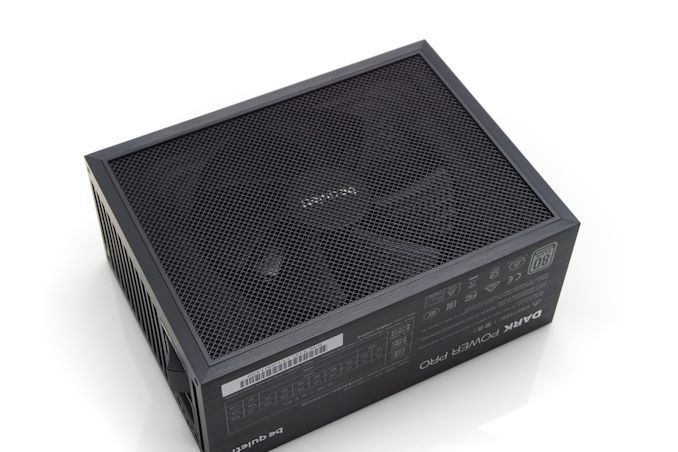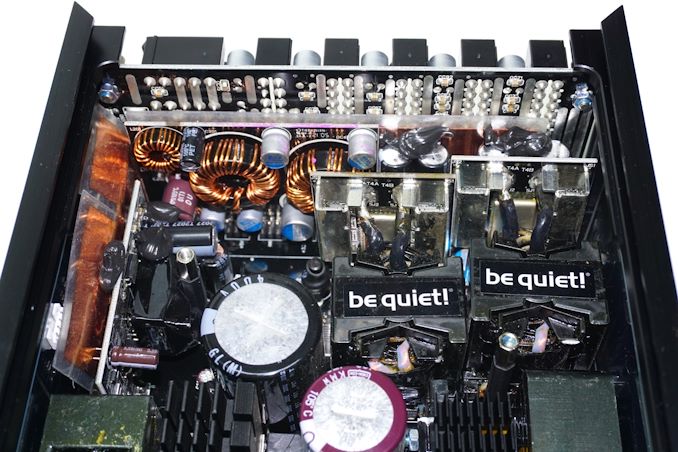The Be Quiet! Dark Power Pro 1500W PSU Review: Big Power
by E. Fylladitakis on January 10, 2022 9:00 AM EST- Posted in
- Cases/Cooling/PSUs
- PSUs
- be quiet!
- 1500W
- 80Plus Titanium
Power Supply Quality
As part of our testing, we also check output parameters are within specifications, as well as voltage ripple and line noise.
| Main Output | ||||||||
| Load (Watts) | 302.18 W | 754.28 W | 1127.44 W | 1500.41 W | ||||
| Load (Percent) | 20.15% | 50.29% | 75.16% | 100.03% | ||||
| Amperes | Volts | Amperes | Volts | Amperes | Volts | Amperes | Volts | |
| 3.3 V | 2.34 | 3.39 | 5.85 | 3.38 | 8.77 | 3.36 | 11.69 | 3.35 |
| 5 V | 2.34 | 5.05 | 5.85 | 5.04 | 8.77 | 5.01 | 11.69 | 4.99 |
| 12 V | 23.38 | 12.08 | 58.46 | 12.06 | 87.69 | 12.02 | 116.91 | 12 |
| Line | Regulation (20% to 100% load) |
Voltage Ripple (mV) | |||||
| 20% Load | 50% Load | 75% Load | 100% Load | CL1 12V |
CL2 3.3V + 5V |
||
| 3.3V | 1.1% | 8 | 10 | 16 | 16 | 10 | 20 |
| 5V | 1.25% | 10 | 12 | 16 | 18 | 14 | 20 |
| 12V | 0.6% | 10 | 16 | 18 | 30 | 36 | 26 |
The electrical performance of the Dark Power Pro 12 is exceptional, and is exactly what we'd expect from a flagship product such as this. Our instruments recorded a maximum ripple of 30 mV on the combined 12V line - a mere quarter of the 120 mV recommended design limit on a unit that outputs 1.5 kW. The filtering on the 3.3V and 5V lines is very good but not as impressive, with 16 mV and 18 mV on the 3.3V and 5V lines respectively. Voltage regulation is exceptional on the 12V line, holding at 0.6% across the entire nominal load range. The 3.3V and 5V lines are less strictly regulated, at about 1.2% according to our readings.
Conclusion
Be Quiet! obviously designed and marketed the Dark Power Pro 12 as a prime example of their brand name – a halo product, a testament of the company’s ability to design and produce top-tier units. And while the company isn't looking to name competitors, Be Quiet! is clearly taking a shot at Corsair and their fully digital AX1600i, a design that many (ourselves included) consider to be the best consumer PSU ever made. To go against the AX1600i is a very ambitious and respectable move, especially considering that only a handful of companies have ever tried.
As a result, the 80Plus Titanium certified Dark Power Pro 12 1500W PSU is very impressive on paper. Yet our closer inspection and testing revealed that it is not quite on par with the fully digital AX1600i, both technologically and otherwise.
The electrical performance of the Dark Power Pro 12 is excellent. Yet it still feels inadequate in some ways. We would have been very impressed by the power quality of the Dark Power Pro 12 were it was a middle to high tier product, but as a flagship product, there's no reason to expect anything but the best from such a PSU. The filtering of the voltage lines is excellent and they are very well regulated, especially when taking the very high 1500 Watt power output into account, but it still is not on par with the ludicrous performance figures that a fully digital platform can deliver. The digital-analog hybrid platform from CWT also has other electrical performance limitations, which are apparent on the power quality of the analogically controlled minor lines and the inability to reach very high-efficiency figures when powered from a 230 VAC source.
Still, it is worthwhile to point out that this platform is the only high power output platform currently available in the North American and European markets that offers multiple virtual 12V rails. Whether the presence of multiple rails is a good thing or not is a topic for debate – multiple rails are safer, as the protection circuitry will not allow a single cable or connector to draw the entirely of the unit’s power output and be damaged. But, on the other hand, balancing the load between the rails is necessary. To that end, we would strongly suggest users keep the power supply in its default mode and only switch overclocking mode on (and let the Dark Power Pro 12 monitor its 12V output as a single power rail) if they face trouble powering a very power-hungry device from a single connector.
The thermal and acoustics performance of the Dark Power Pro 12 are both better than we initially expected from such a powerful unit, even from one bearing an 80Plus Titanium efficiency certification. Under normal operating circumstances, the Dark Power Pro 12 should remain almost dead silent, as it takes a very high load for the thermal control circuitry to even bother speeding up the cooling fan. Otherwise, if the unit finds itself operating in an adverse environment and/or is very heavily loaded, it will protect itself by sacrificing acoustics over reliability.
Finally, it's clear that Be Quiet! has invested a significant amount of effort in order to make the Dark Power Pro 12 aesthetically unique – a PSU that stands out from the rest at first sight but without compromising the company’s profile of elegance and subtleness. The designers developed a unique layered chassis with a brushed metallic exterior shell and an equally unique metal mesh fan cover, which makes for a product that radiates quality without being extravagant. And this high level of design quality for the Dark Power Pro 12 is not just at a superficial level; Be Quiet has used top-quality components on the inside as well, down to the least important capacitor. Fittingly, Be Quiet! backs the Dark Power Pro 12 with a 10-year manufacturer warranty.
The Dark Power Pro 12 1500W unit is a very powerful PSU, capable of driving almost anything, but also giving it a very limited market potential, especially in the current PC market where video cards are scarce and extremely expensive. It also has to take on the venerable Corsair AX1600i, the performance reference of any top-tier PSU. Only a handful of companies have even dared to try and take on the Flextronics-based AX1600i, which underscores the value in (and confidence of) Be Quiet!’s engineers for even trying. Still, the digital-analog hybrid platform from CWT cannot outperform the AX1600i in terms of performance, nor make Flextronics engineers feel uneasy at all.
The overall performance of the Dark Power Pro 12 is great, but it's just not enough to steal the crown of the best consumer PC PSU ever made. Nonetheless, Be Quiet! has a massive advantage when it comes to overall value – the Dark Power Pro 12 1500W currently retails for $450, which is half the price of Corsair’s AX1600i. So for builders who do need a 1500W+ PSU but do not care about having the best possible performance, the Dark Power Pro 12 shines in its own way as a far more economical choice.













41 Comments
View All Comments
Speed-o - Monday, January 10, 2022 - link
Given that SLI is basically dead, what's the primary market for a 1500W PSU these days?The 3090 is a total porker. But even that and a 12900K is below 1000 watts, isn't it?
meacupla - Monday, January 10, 2022 - link
maybe RTX3090+12900K will be under 1000W on sustained loads, but when it comes to transient loads, 1000W is unlikely to be enough.RTX3090 transient load spike is reported by seasonic to be upwards of 550W. If you want to leave a bit of headroom with a 12900K, you're probably looking at, at least, 1200W PSU.
And then we also have the RTX3090Tie incoming, which is even known to be more power hungry than RTX3090. So maybe 1500W will be the new 'norm' for high end gaming desktops.
austinsguitar - Monday, January 10, 2022 - link
usually a 1200w psu has an ocp of up to 1500w or so. how they deal with that is different, but 1200w will still probably be the maximum needed.Showtime - Friday, January 14, 2022 - link
How are you mixing transient loads with sustained loads? If transients are 550w according to you, how are the sustained loads 1k? The issue with transient loads is the spike/speed, and any decent 850w PSU will cover it. Problem is too many people have a little bit of information, but understand the whole picture. For a gaming there is no situation where the GPU, and 12900k will be under full load. You are either GPU, or CPU limited, and there are no games fully utilize 16 threads. That's why you can use power consumption (GPU+CPU) as measured by 3rd party sites, give yourself 100w of headroom, and can be fine with any decent PSU. The only people who had issues after that, were using cheap PSU's, or unit's with design, or QC issues, like those EVGA's a couple years back.satai - Tuesday, January 11, 2022 - link
SLI may be dead but multiple GPUs for computation are not dead.shabby - Tuesday, January 11, 2022 - link
Or mining...lilkwarrior - Wednesday, January 12, 2022 - link
mGPU is not dead. The 3090 and up have NVLINK for a reason. You're talking like you're a gamer. Productive GPU users use mGPU all the time; even the 2019 Mac Pro has 1400W and optimized for mGPU rendering.lilkwarrior - Wednesday, January 12, 2022 - link
Note that all that happened in gaming is that Microsoft in a consumer-first move delegated mGPU mode to game software engineers instead of allowing Nvidia, AMD, or any new player like Intel from dominating mGPU rendering in games by the means of drivers.DX12 mGPU even allows you to use iGPU and dGPUs together, pool the memory of multiple GPUs, and use GPUs from different vendors together.
Game developers haven't elected to leverage it; that said, a single GPU could do 4K@60hz which was last gen's optimal target being the max for HDMI 2.0 for the highest tier consoles; gaming is a console-oriented business.
With current-gen consoles and HDMI 2.1, it can be more feasible again to pursue mGPU gaming support by game developers to accommodate 4K@120hz which will be the standard for the highest end version of PS5 (PS5 Pro) and Series X (who knows what that will be called).
lilkwarrior - Wednesday, January 12, 2022 - link
I will emphasize SLI is dead because it's deliberately replaced by DX12 mGPU mode which makes much more sense–especially now that Intel is also making dGPUs.It should stay dead because it's 2022. Current gen games should be permanently making the transition to DX12 and Vulkan that both support DX12 mGPU mode.
Xajel - Thursday, January 13, 2022 - link
Multi GPU for compute is not dead, PS. some people try to not fully saturate their PSU, this keeps their PSU cool, lengthen it's life time, and maybe even give it more efficiency.